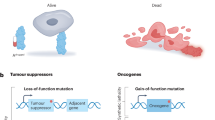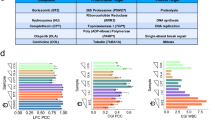Abstract
Abundant evidence suggests that a unifying principle governing the molecular pathology of cancer is the co-dependent aberrant regulation of core machinery driving proliferation and suppressing apoptosis1. Anomalous proteins engaged in support of this tumorigenic regulatory environment most probably represent optimal intervention _targets in a heterogeneous population of cancer cells. The advent of RNA-mediated interference (RNAi)-based functional genomics provides the opportunity to derive unbiased comprehensive collections of validated gene _targets supporting critical biological systems outside the framework of preconceived notions of mechanistic relationships. We have combined a high-throughput cell-based one-well/one-gene screening platform with a genome-wide synthetic library of chemically synthesized small interfering RNAs for systematic interrogation of the molecular underpinnings of cancer cell chemoresponsiveness. NCI-H1155, a human non-small-cell lung cancer line, was employed in a paclitaxel-dependent synthetic lethal screen designed to identify gene _targets that specifically reduce cell viability in the presence of otherwise sublethal concentrations of paclitaxel. Using a stringent objective statistical algorithm to reduce false discovery rates below 5%, we isolated a panel of 87 genes that represent major focal points of the autonomous response of cancer cells to the abrogation of microtubule dynamics. Here we show that several of these _targets sensitize lung cancer cells to paclitaxel concentrations 1,000-fold lower than otherwise required for a significant response, and we identify mechanistic relationships between cancer-associated aberrant gene expression programmes and the basic cellular machinery required for robust mitotic progression.
This is a preview of subscription content, access via your institution
Access options
Subscribe to this journal
Receive 51 print issues and online access
We are sorry, but there is no personal subscription option available for your country.
Buy this article
- Purchase on SpringerLink
- Instant access to full article PDF
Prices may be subject to local taxes which are calculated during checkout



Similar content being viewed by others
References
Green, D. R. & Evan, G. I. A matter of life and death. Cancer Cell 1, 19–30 (2002)
Chien, Y. & White, M. A. RAL GTPases are linchpin modulators of human tumour-cell proliferation and survival. EMBO Rep. 4, 800–806 (2003)
Matheny, S. A. et al. Ras regulates assembly of mitogenic signalling complexes through the effector protein IMP. Nature 427, 256–260 (2004)
Malo, N., Hanley, J. A., Cerquozzi, S., Pelletier, J. & Nadon, R. Statistical practice in high-throughput screening data analysis. Nature Biotechnol. 24, 167–175 (2006)
Benjamini, Y. H. Y. Controlling the false discovery rate: a practical and powerful approach to multiple testing. J. R. Statist. Soc. B 57, 2890300 (1995)
Allison, D. B., Cui, X., Page, G. P. & Sabripour, M. Microarray data analysis: from disarray to consolidation and consensus. Nature Rev. Genet. 7, 55–65 (2006)
Wit, E. & McClure, J. Statistical adjustment of signal censoring in gene expression experiments. Bioinformatics 19, 1055–1060 (2003)
Benjamini, Y. & Hochberg, Y. Controlling the false discovery rate: a practical and powerful approach to multiple testing. J. R. Statist. Soc. B 57, 289–300 (1995)
Jordan, M. A. & Wilson, L. The use and action of drugs in analyzing mitosis. Methods Cell Biol. 61, 267–295 (1999)
Moritz, M. & Agard, D. A. Gamma-tubulin complexes and microtubule nucleation. Curr. Opin. Struct. Biol. 11, 174–181 (2001)
Jordan, M. A. & Wilson, L. Microtubules as a _target for anticancer drugs. Nature Rev. Cancer 4, 253–265 (2004)
Scanlan, M. J., Simpson, A. J. & Old, L. J. The cancer/testis genes: review, standardization, and commentary. Cancer Immun. 4, 1–15 (2004)
Toschi, L., Finocchiaro, G., Bartolini, S., Gioia, V. & Cappuzzo, F. Role of gemcitabine in cancer therapy. Future Oncol. 1, 7–17 (2005)
Weaver, B. A. & Cleveland, D. W. Decoding the links between mitosis, cancer, and chemotherapy: The mitotic checkpoint, adaptation, and cell death. Cancer Cell 8, 7–12 (2005)
Ramirez, R. D. et al. Immortalization of human bronchial epithelial cells in the absence of viral oncoproteins. Cancer Res. 64, 9027–9034 (2004)
Rieder, C. L. & Maiato, H. Stuck in division or passing through: what happens when cells cannot satisfy the spindle assembly checkpoint. Dev. Cell 7, 637–651 (2004)
Davies, A. M. et al. Bortezomib-based combinations in the treatment of non-small-cell lung cancer. Clin. Lung Cancer 7, (Suppl 2)S59–S63 (2005)
Kawasaki-Nishi, S., Nishi, T. & Forgac, M. Proton translocation driven by ATP hydrolysis in V-ATPases. FEBS Lett. 545, 76–85 (2003)
Boyd, M. R. et al. Discovery of a novel antitumor benzolactone enamide class that selectively inhibits mammalian vacuolar-type (H+)-ATPases. J. Pharmacol. Exp. Ther. 297, 114–120 (2001)
Xie, X. S. et al. Salicylihalamide A inhibits the V0 sector of the V-ATPase through a mechanism distinct from bafilomycin A1. J. Biol. Chem. 279, 19755–19763 (2004)
Wu, Y., Liao, X., Wang, R., Xie, X. S. & De Brabander, J. K. Total synthesis and initial structure–function analysis of the potent V-ATPase inhibitors salicylihalamide A and related compounds. J. Am. Chem. Soc. 124, 3245–3253 (2002)
Skehan, P. et al. New colorimetric cytotoxicity assay for anticancer-drug screening. J. Natl Cancer Inst. 82, 1107–1112 (1990)
Acknowledgements
This work was supported by grants from the National Cancer Institute, the Robert E. Welch Foundation, the Susan G. Komen Foundation, the Department of Defense Congressionally Directed Medical Research Program and the National Cancer Institute Lung Cancer Specialized Program of Research Excellence.
Author information
Authors and Affiliations
Corresponding author
Ethics declarations
Competing interests
Reprints and permissions information is available at www.nature.com/reprints. The authors declare no competing financial interests.
Supplementary information
Supplementary Table 1
This file contains Supplementary Table 1 which shows full data set containing mean, S.D., p-values, and associated gene annotations from the genome-wide screen. (XLS 9352 kb)
Supplementary Table 2
This file contains Supplementary Table 2 which shows 5% FDR gene list. (XLS 70 kb)
Supplementary Table 3
This file contains Supplementary Table 3 which shows 2.5 percentile gene list. (XLS 68 kb)
Supplementary Table 4
This file contains Supplementary Table 4 which shows p-values and FDR values for genes described in Figure 2. (XLS 24 kb)
Supplementary Table 5
This file contains Supplementary Table 5 which shows siRNA sequences corresponding to the HC hit list. (XLS 39 kb)
Supplementary Table 6
This file contains Supplementary Table 6 which shows transfection conditions for all cell lines used in this study. (XLS 18 kb)
Supplementary Table 7
This file contains Supplementary Table 7 which shows primer sequences used for quantitative rtPCR. (XLS 19 kb)
Supplementary Information
This file contains Supplementary Figures 1-6 with Legends and Supplementary Methods (PDF 1110 kb)
Rights and permissions
About this article
Cite this article
Whitehurst, A., Bodemann, B., Cardenas, J. et al. Synthetic lethal screen identification of chemosensitizer loci in cancer cells. Nature 446, 815–819 (2007). https://doi.org/10.1038/nature05697
Received:
Accepted:
Issue Date:
DOI: https://doi.org/10.1038/nature05697
This article is cited by
-
Characterization of a prognostic model for lung squamous cell carcinoma based on eight stemness index-related genes
BMC Pulmonary Medicine (2022)
-
Integrated RNAi screening identifies the NEDDylation pathway as a synergistic partner of azacytidine in acute myeloid leukemia
Scientific Reports (2021)
-
Harnessing synthetic lethality to predict the response to cancer treatment
Nature Communications (2018)
-
Combine and conquer: challenges for _targeted therapy combinations in early phase trials
Nature Reviews Clinical Oncology (2017)
-
Cyclopamine tartrate, an inhibitor of Hedgehog signaling, strongly interferes with mitochondrial function and suppresses aerobic respiration in lung cancer cells
BMC Cancer (2016)



